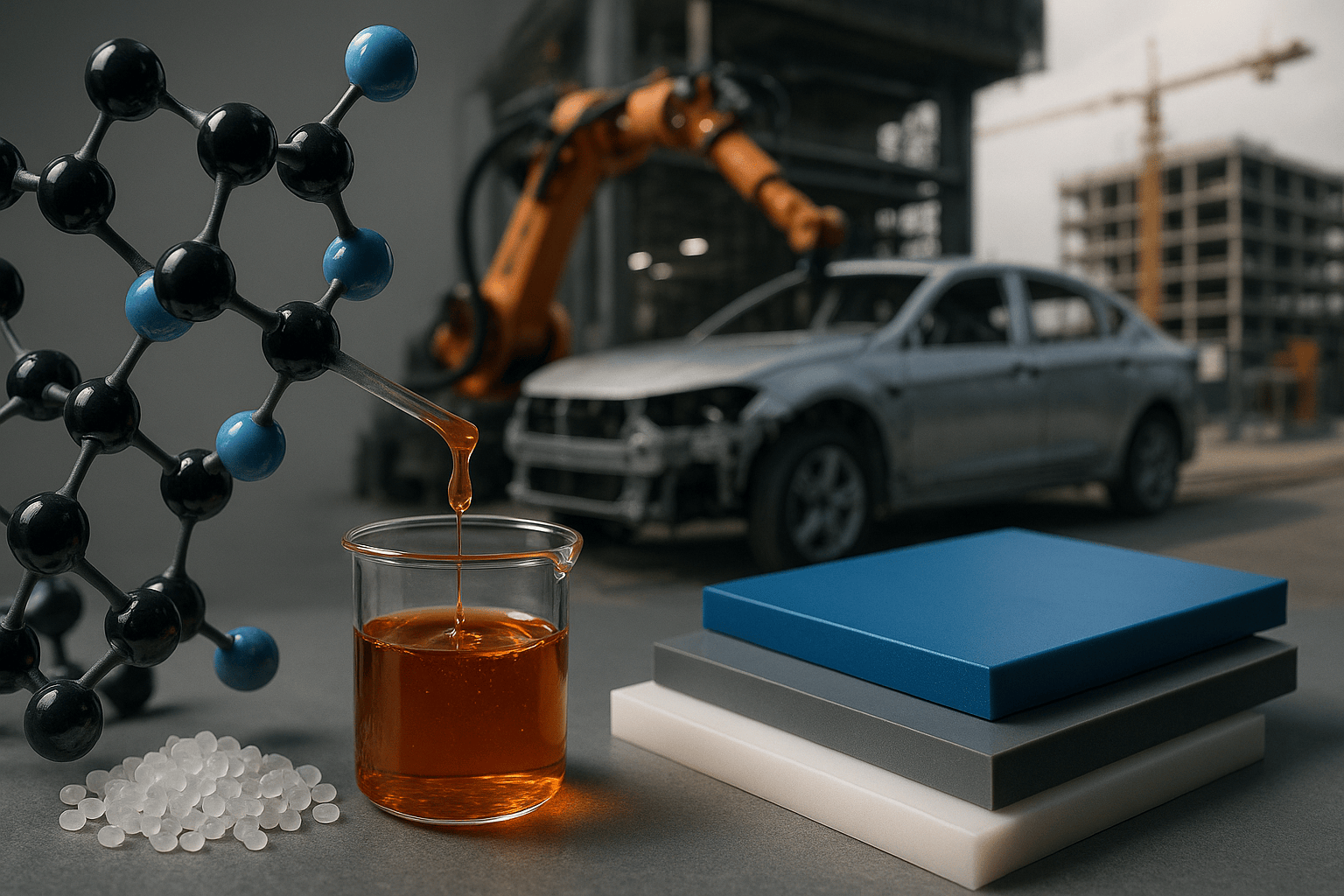Polymer vs Resin: What’s the Difference and Why It Matters?

You’re browsing products in a store, from plastic bottles to glossy furniture coatings, and a question pops up: what makes these things so versatile? The answer lies in two words—polymers and resins. These chemical wizards are behind everything from your stretchy yoga pants to the durable paint on your car. But are they the same thing, or is there a difference that changes how they’re used? Understanding the distinction between polymers and resins can unlock smarter choices for manufacturers, crafters, or anyone curious about modern materials. In Pakistan, where industries thrive on innovative materials, this knowledge is key. This blog dives into what sets polymers and resins apart, their roles in manufacturing, and why it matters, with insights on sourcing from a polymer supplier in Pakistan. Let’s unravel the chemistry and see how these materials shape our world!
What Are Polymers?
Polymers are large molecules made of repeating monomer units, forming chains or networks that create a wide range of materials used daily.
- Molecular Structure – Monomers, like ethylene or styrene, link together through chemical reactions to form flexible or rigid polymers.
- Natural Examples – Found in nature as cellulose in plants or proteins like keratin in hair, used for centuries in textiles and more.
- Synthetic Varieties – Engineered polymers, like polyethylene or nylon, are designed for specific traits like strength or flexibility.
- Versatile Applications – Used in plastics, textiles, and rubber, polymers are key in industries from packaging to automotive.
- Pakistan’s Market – Chemical suppliers in Pakistan provide polymers for textiles, construction, and more, fueling local production.
What Defines Resins?
Resins are a specialized subset of polymers, often viscous or sticky, that harden into durable materials for coatings, adhesives, or composites.
- Sticky Origins – Resins, like epoxy or polyester, start as liquids or semi-liquids, curing into solid forms for industrial use.
- Polymer Subcategory – All resins are polymers, but not all polymers are resins; resins are defined by their hardening properties.
- Key Examples – Epoxy for coatings, phenolic for insulation, or natural resins like amber, used in traditional crafts.
- Curing Process – Resins harden through chemical reactions or heat, creating strong, permanent structures for various applications.
- Industrial Demand – In Pakistan, resins are sourced from chemical suppliers for construction, electronics, and furniture industries.
Polymers build the world’s materials; resins make them stick, shine, and last.
How Do Polymers and Resins Differ in Composition and Use?
While all resins are polymers, their composition and applications set them apart, impacting their role in manufacturing. Polymers are broad, encompassing any large molecule with repeating units, like plastics (polyethylene) or fibers (polyester), used in everything from bottles to clothing. Resins, a specific type of polymer, are typically viscous and harden into rigid or semi-rigid forms, making them ideal for adhesives, coatings, or composites like fiberglass. Polymers offer flexibility in form—liquid, solid, or elastic—while resins focus on binding or protective roles. For example, a polymer like PVC forms pipes, while an epoxy resin coats those pipes for durability. In Pakistan, industries use polymers for mass-produced goods and resins for specialized tasks, with suppliers tailoring materials to specific needs. Understanding these differences helps manufacturers choose the right material for cost, performance, or sustainability.
Why Does the Difference Between Polymers and Resins Matter?
The distinction between polymers and resins impacts manufacturing decisions, product performance, and costs.
- Application Specificity – Polymers suit diverse needs (e.g., flexible plastics), while resins excel in bonding or protective roles (e.g., coatings).
- Cost Considerations – Resins, like epoxy, can be pricier due to specialized production, while polymers like polyethylene are cheaper for bulk use.
- Durability Factors – Resins provide permanent, heat-resistant finishes; polymers vary in durability based on type (e.g., elastic rubber vs. rigid PVC).
- Production Efficiency – Polymers enable fast molding for mass production; resins require curing time, affecting manufacturing timelines.
- Industry Choices – In Pakistan, manufacturers select polymers for textiles and resins for construction, guided by performance needs.
Comparing Polymers and Resins
| Material | Composition | Key Features | Common Uses | Cost (PKR/kg, 2025) |
| Polymers | Repeating monomers | Flexible, elastic, or rigid | Plastics, textiles, rubber | 200-800 |
| Resins | Subset of polymers | Viscous, hardens permanently | Coatings, adhesives, composites | 500-1,500 |
What Are the Key Industrial Uses of Polymers?
Polymers are versatile, powering a range of industries with their adaptable properties.
- Packaging – Polyethylene and PET create lightweight, recyclable containers for food, beverages, and cosmetics, ensuring safety and affordability.
- Textiles – Polyester fibers form durable, stretchy fabrics for clothing, carpets, or ropes, key in Pakistan’s export market.
- Automotive – Polypropylene reduces vehicle weight in bumpers or dashboards, improving fuel efficiency and safety.
- Construction – PVC pipes and fittings offer durability and corrosion resistance for plumbing and infrastructure projects.
- Electronics – Polycarbonate casings protect phones and laptops, balancing strength with lightweight design.
What Are the Main Applications of Resins?
Resins excel in specialized roles, enhancing durability and functionality in targeted applications.
- Protective Coatings – Epoxy resins shield surfaces in cars, buildings, or electronics, resisting corrosion and wear for longevity.
- Adhesives – Polyester resins bond materials in construction or aerospace, ensuring strong, reliable joints.
- Composites – Resins combine with fibers to create lightweight, strong materials for boat hulls or wind turbine blades.
- Electrical Insulation – Phenolic resins protect circuits in electronics, ensuring safety in high-voltage environments.
- Furniture Finishes – Resins add glossy or matte coatings to tables or cabinets, enhancing aesthetics and durability.
Polymers shape the form; resins seal the deal with strength and shine.
How Do Polymers and Resins Impact Pakistan’s Industries?
Pakistan’s manufacturing sector relies heavily on polymers and resins to drive growth and innovation.
- Textile Dominance – Polymers like polyester fuel Pakistan’s clothing exports, creating affordable, durable fabrics for global markets.
- Packaging Boom – Polyethylene polymers ensure safe, lightweight packaging for food and exports, supporting local commerce.
- Construction Growth – Resins like epoxy strengthen coatings and adhesives, while PVC polymers provide pipes for urban projects.
- Electronics Sector – Polymers form casings, and resins insulate circuits, supporting Pakistan’s emerging tech manufacturing.
- Automotive Industry – Lightweight polymers and durable resin coatings enhance vehicle efficiency and aesthetics in local production.
Are Polymers and Resins Environmentally Sustainable?
The environmental impact of polymers and resins is a key concern, with solutions emerging to address challenges.
- Plastic Waste – Non-biodegradable polymers like polyethylene contribute to pollution if not recycled, a challenge in Pakistan’s waste systems.
- Resin Emissions – Resin production can release volatile compounds, requiring careful management to minimize environmental harm.
- Recycling Efforts – Recycled polymers (e.g., PET from bottles) and some resins reduce waste, with Pakistan expanding recycling infrastructure.
- Bio-Based Options – Polylactic acid (PLA) polymers and eco-friendly resins from renewable sources offer greener alternatives.
- Energy Use – Polymer and resin production is energy-intensive, but low-impact processes are gaining traction among suppliers.
Polymers and resins can build a sustainable future if we weave recycling into their story.
How to Choose a Polymer Supplier in Pakistan?
Selecting a reliable supplier ensures quality polymers and resins for your manufacturing needs.
- Broad Material Range – Seek suppliers offering thermoplastics, thermosets, and bio-based polymers for diverse industrial applications.
- Quality Assurance – Trusted suppliers provide tested materials with consistent properties, ensuring reliable performance in products.
- Local Expertise – Suppliers familiar with Pakistan’s textile, construction, or packaging needs can recommend tailored solutions.
- Reliable Logistics – Choose suppliers with efficient delivery systems to meet production deadlines, avoiding costly delays.
- Eco-Friendly Options – Opt for suppliers offering recycled polymers or low-impact resins to align with global sustainability trends.
What’s the Future of Polymers and Resins in Manufacturing?
Polymers and resins are evolving to meet modern demands, balancing functionality with environmental responsibility.
- Sustainable Materials – Bio-based polymers and eco-friendly resins reduce reliance on fossil fuels, gaining popularity in Pakistan.
- Smart Polymers – Self-healing or conductive resins are emerging for advanced uses in medical devices and wearable tech.
- Recycling Innovations – Chemical recycling breaks down polymers into reusable monomers, supporting a circular economy.
- Energy Efficiency – Cleaner production methods, like low-emission reactors, cut the carbon footprint of polymer and resin manufacturing.
- Pakistan’s Growth – Local suppliers are adopting sustainable practices, positioning Pakistan as a hub for innovative material solutions.
Polymers and resins are the threads of tomorrow, weaving strength, flexibility, and sustainability into manufacturing.
FAQs About Polymers and Resins
What’s the key difference between polymers and resins?
Polymers are broad molecules with repeating units; resins are polymers that harden into coatings or adhesives for specific uses.
Why does the difference between polymers and resins matter?
It impacts material choice—polymers for flexibility, resins for bonding or protection—affecting cost, durability, and application.
Are polymers and resins safe for consumer products?
Yes, when manufactured to standards, they’re safe for packaging, clothing, or medical devices, with rigorous testing.
How do polymers and resins affect the environment?
Non-biodegradable types contribute to waste, but recycling and bio-based options reduce impact, available from some suppliers.
Which industries use polymers and resins the most?
Textiles, packaging, construction, automotive, and electronics rely on them for versatility, strength, and cost savings.
How can I find a reliable polymer supplier in Pakistan?
Look for suppliers in Karachi or Lahore with diverse, tested materials, local expertise, and sustainable options.
What are the cost differences between polymers and resins?
Polymers like polyethylene are cheaper (PKR 200-800/kg); resins like epoxy are pricier (PKR 500-1,500/kg) due to specialized uses.
Are there eco-friendly polymer and resin options?
Yes, bio-based polymers like PLA and low-VOC resins reduce environmental harm, offered by select Pakistani suppliers.
Wrapping Up
Polymers and resins are the dynamic duo of modern manufacturing, with polymers offering versatility and resins delivering durable, specialized solutions. Their differences—flexibility versus hardening properties—shape their roles in textiles, construction, and electronics, driving efficiency and innovation. In Pakistan, where industries fuel economic growth, chemical suppliers provide the materials to power progress. Despite environmental challenges, recycling and bio-based options are paving a sustainable path. Whether you’re crafting products or exploring material science, understanding these materials unlocks smarter choices. Ready to shape your next project? Connect with a trusted supplier and let polymers and resins bring your ideas to life!
Read More Article At SparkArticles!



